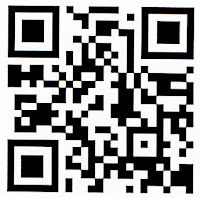Curiouser and curiouser...
Check out this little black and white box, it's part of the Brave New World. It's called a "QR" Code. It's an improved version of a bar code. Very basically, it's what you get if you took two bar codes and overlapped them, with one turned perpendicular to the other. Each black or white box forms a pixel in a grid, and the entire grid is a matrix. Data stored in matrix form tends to take up less space than in linear binary form (i.e. a bar code), while at the same time, a matrix can hold more data.
For example, a bar code can hold up to 20 numbers, wheras a QR Code can hold up to 7,089. A QR Code cans also store text or pictographic information, like Japanese kanji writing. At the same time, a QR code can be up to ten times smaller than a bar code and still be legible. The one I have posted above is greatly enlarged for artistic merit.
A QR Code can be read by any device with a camera and QR software. Smart phones generally come with QR apps built in, or with the ability to use a freeware QR app. Simply scan the QR box with your smartphone, and you will see the data right away. In this case, my QR Code links here to my blog, JSVB.
QR Codes can be read from computer screens or printed out. The boxes in the corners provide alignment cues so that even if you take the picture crooked, the data will still be read correctly.
"QR" stand for "Quick Response", and was originally designed by the Denso Wave Corporation of Japan in 1994 as a means to track packages and industrial parts. Although Denso owns the patent rights to the QR Code, the code is free for public use. The actual name "QR Code" is a trademark of Denso Wave.
I created this code using free online software. Many thanks to Allan who double-confirmed that my JSVB QR Code actually links properly to JSVB and not some crazy porn site.






